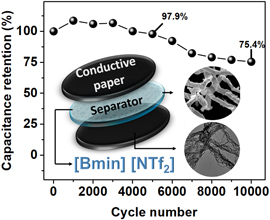Crossref Citations
This article has been cited by the following publications. This list is generated based on data provided by
Crossref.
Vargun, Elif
Ozaltin, Kadir
Fei, Haojie
Harea, Evghenii
Vilčáková, Jarmila
Kazantseva, Natalia
and
Saha, Petr
2020.
Biodegradable porous polylactic acid film as a separator for supercapacitors.
Journal of Applied Polymer Science,
Vol. 137,
Issue. 42,
Wu, Xiao
Zhang, Mingquan
Song, Tao
Mou, Hongyan
Xiang, Zhouyang
and
Qi, Haisong
2020.
Highly Durable and Flexible Paper Electrode with a Dual Fiber Matrix Structure for High-Performance Supercapacitors.
ACS Applied Materials & Interfaces,
Vol. 12,
Issue. 11,
p.
13096.
Zhang, Lin
Meng, Chaoran
Fu, Jiajia
Lou, Jiangfei
Zhang, Xun
Gao, Weidong
and
Fan, Xuerong
2022.
Effect of ozone treatment on the chemical and mechanical properties of flax fibers.
Industrial Crops and Products,
Vol. 189,
Issue. ,
p.
115694.
Xu, Daman
Heng, Yingqi
Qin, Xiang
and
Hu, Dongying
2022.
Membrane-based symmetric supercapacitors composed of cellulose solution-derived polydopamine-modified separators and polypyrrole/graphene-doped polydopamine-modified electrodes.
Journal of Energy Storage,
Vol. 50,
Issue. ,
p.
104640.
Sheoran, Karamveer
Kaur, Harjot
Siwal, Samarjeet Singh
and
Thakur, Vijay Kumar
2023.
Dual Role is Always Better than Single: Ionic Liquid as a Reaction Media and Electrolyte for Carbon‐Based Materials in Supercapacitor Applications.
Advanced Energy and Sustainability Research,
Vol. 4,
Issue. 9,
Khan, Ashaduzzaman
Ashrafuzzaman, Md.
Biswas, Shuvrodev
Kabiraz, Dulal Chandra
and
Hossain, Gaffar
2024.
Textile geometry associated with advanced nanomaterials for high rate supercapacitors.
Journal of Energy Storage,
Vol. 75,
Issue. ,
p.
109648.
Sharma, Naman
Mishra, Kirti
Singh, Nirankar
Siwal, Samarjeet Singh
Hart, Phil
and
Thakur, Vijay Kumar
2025.
Harnessing Nature‐Derived Sustainable Materials for Electrochemical Energy Storage: Unveiling the Mechanism and Applications.
Macromolecular Materials and Engineering,
Vol. 310,
Issue. 1,


